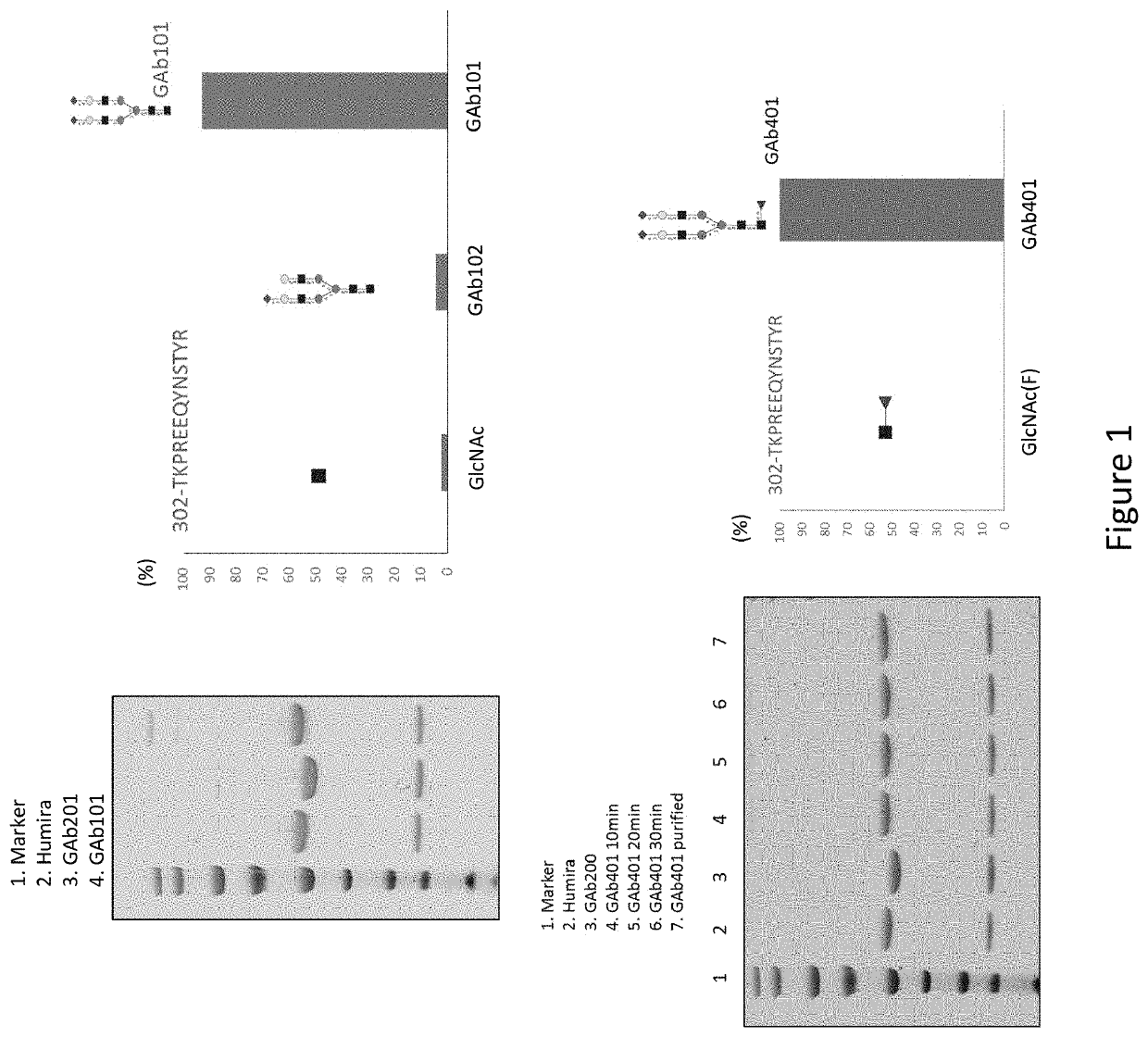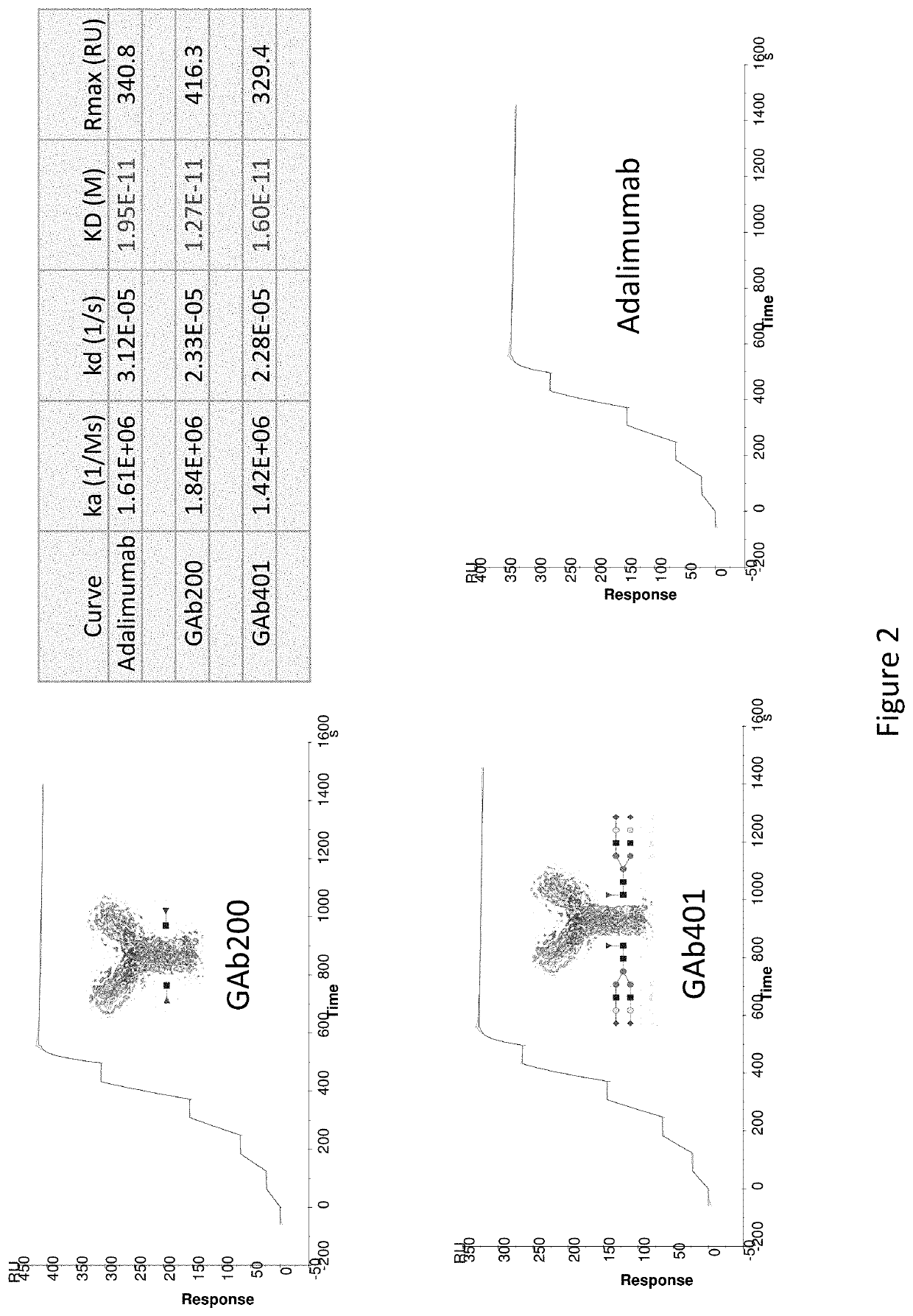Anti-TNF-alpha glycoantibodies and uses thereof
a glycoantibody and anti-tnf technology, applied in the field of therapeutic monoclonal antibodies, can solve the problems of reducing the life span of the circulatory system of the drug, affecting the effector function of the therapeutic antibody, and provoking immunogenicity, so as to improve the therapeutic value and increase the binding affinity of tn
- Summary
- Abstract
- Description
- Claims
- Application Information
AI Technical Summary
Benefits of technology
Problems solved by technology
Method used
Image
Examples
example 1
General procedure for analysis of N-glycosylation of anti-TNFα
[0186]We developed a mass spectrometric method to monitor the yield of oligosaccharide-derived fragment ions (oxonium ions) over a collision induced dissociation (CID) energy applied to a glycopeptides precursor. Multiple Reaction Monitoring (MRM) of oxonium ions method could fulfill the regulatory requirement on the routine quality control analysis of forthcoming biosimilar therapeutics.
[0187]5 ug of Adalimumab(HUMIRA™) (purchased from Abbvie) was dissolved in 25 ul of 2M Guanidine-HCl, and dithiothreitol (DTT) were added to a final concentration of 5 mM. After 10 minutes incubation in 110° C., reduced cysteine residues were alkylated in 10 mM Iodoacetamide (IAA) at 37° C. for 1 hour. Add 5 mM DTT to quench excess IAA at RT for 10 minutes. The product was diluted 15 times in 50 mM ammonium bicarbonate before microcentrifugation with spin column (10 kDa protein MW cut-off). The trypsin digestion was performed for 4 hours ...
example 2
Generation of Exemplary Anti-TNFα GAbs
Anti-TNFα GAb301
[0190]The complete removal of N-linked glycan at Asn297 from Fc region of Adalimumab is achieved by means of PNGase F, and evaluated with 4-12% Bis-Tris NeuPAGE and LC-MS / MS analysis of tryptic glycopeptides from modified and unmodified IgG. The molecular weights of tryptic glycopeptides were used to determine the potential site of N-linked glycosylation at each asparagine and to elucidate the species of predominant glycans.
Anti-TNFα GAb200
[0191]Adalimumab (2.5 mg) in a sodium phosphate buffer (50 mM, pH 7.0, 1.25 mL) was incubated with Endo S (125 μg) at 37° C. for 5 h to yield a disaccharide (GlcNAc-Fuc) on Fc of Adalimumab (anti-TNFα GAb200). The reaction mixture was subject to affinity chromatography on a column of protein A-agarose resin (1 mL) that was pre-equilibrated with a sodium phosphate buffer (20 mM, pH 7.0). The column was washed with a sodium phosphate buffer (20 mM, pH 7.0, 10 mL). The bound IgG was released with ...
example 3
Binding Affinity of Exemplary Anti-TNFα GAbs
[0211]Human recombinant TNF-α containingg 158 amino acids (MW=17.5 kDa) was produced in E. coli (PROSPEC) and purified. Recombinant human TNF-α protein was titrated and a serial dilution of 50 nM, 25 nM, 12.5 nM, 6.25 nM, and 3.125 nM was prepared in FIBS-EP buffer. Adalimumab and anti-TNFα GAb 200 and 401 were diluted in HBS-EP buffer to a concentration of 10 μg / ml, and then captured to the CM5 chip where anti-human Fe domain antibodies were pre-immobilized. Serial concentration of recombinant human TNF-alpha as the analyte and then injected and bound to the captured antibody on chip at the flow rate of 30 μl / min. After binding, the antibody-analyte complex were washed by regeneration buffer, 10 mM glycine-HCl pH1.5 at the flow rate of 50 μl / min. CM5 chip was maintained in PBS pH7.4 at 4° C. for further use. Single cycle kinetics data was fitted into 1:1 binding model using Biacore T200 evaluation software to measure the equilibrium const...
PUM
| Property | Measurement | Unit |
|---|---|---|
| concentration | aaaaa | aaaaa |
| concentration | aaaaa | aaaaa |
| concentration | aaaaa | aaaaa |
Abstract
Description
Claims
Application Information
 Login to View More
Login to View More - R&D
- Intellectual Property
- Life Sciences
- Materials
- Tech Scout
- Unparalleled Data Quality
- Higher Quality Content
- 60% Fewer Hallucinations
Browse by: Latest US Patents, China's latest patents, Technical Efficacy Thesaurus, Application Domain, Technology Topic, Popular Technical Reports.
© 2025 PatSnap. All rights reserved.Legal|Privacy policy|Modern Slavery Act Transparency Statement|Sitemap|About US| Contact US: help@patsnap.com



